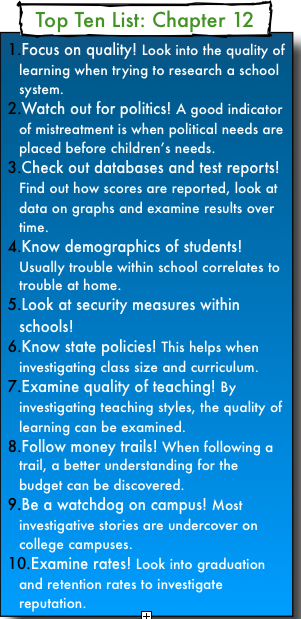Investigating For-Profit and Non-Profit Businesses and Religious Organizations
By Shea Northcut
In an investigation done by Lynda Carson from San Francisco, Carson found out about a nonprofit housing organization named Oakland Community Housing, Inc. After a long duration that city members spent complaining about this organization, the tenants and activists were happy to hear that they were no longer being ignored by the city. It was believed that this organization was spending millions in tax payer dollars on their housing projects.

One member of the community complained that “millions of dollars in funding that has been given to OCHI has corrupted the housing organization. It’s staff stole much of the money through the years and as soon as the City stopped giving money to the organization, everybody disappeared.”
After the city members constructed a petition with over 500 signatures on it and delivered it to the City Council, there was a request to do an investigation on civil actions and criminal charges against Oakland for “fraud, misappropriation and endangering of senior citizens by using City funds for their salaries instead of repairs at their properties.”
Through investigating before any anyone was actually caught, the community members actually became the investigative journalists at first because they did not wait but started their investigation before there was any real proof and evidence. According to Investgatve Reporting, it explained how journalists should request employer’s inspection histories and go to the actual corporation or the worksites to see what the situation is like.
Also, it is vital to conduct interviews in person rather than just making phone calls and to use other forms of documentation. Within this investigation, other non-profit organizations came under scrutiny as well after tenants and activists realized that there was rampant corruption and a lack of oversight occurring.
When doing investigations with non-profits and other religious organizations, it is vital to start looking for the initial signs as soon as possible. Usually, a journalist can start pinpointing signs by looking at other documentation for failing to pay specific wages or monitor and repair specific things within a site.
Filed under: Investigative Reporting Analysis | Tagged: documentation, investigation, journalist, non-profit, organizations, religious, reporting | Leave a comment »


 “These contracts were not competitively bid,” the report states. “Several associated subcontracts were awarded to individuals with ties to TEA senior staff. Key participants in the contracting process do not agree as to how subcontractors were chosen.”
“These contracts were not competitively bid,” the report states. “Several associated subcontracts were awarded to individuals with ties to TEA senior staff. Key participants in the contracting process do not agree as to how subcontractors were chosen.”